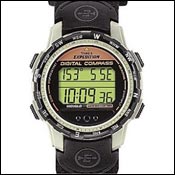I certainly don聮t object to digital compasses. They聮re easy to use and extremely accurate (provided they聮re properly set up for declination, of course). And prices are coming down. Coghlan聮s Big Screen Digital Compass (coghlans.com), for instance, sells for $28. Wrist watch-style compasses, such as the Timex Expedition Digital Compass Watch, sell for around $60.
Timex Expedition Digital Compass Watch
 Expedition Digital Compass Watch
Expedition Digital Compass WatchBut then there is the reliability issue. Coghlan聮s says that the Big Screen compass has a battery life of two years of normal use, meaning the odds the battery goes dead while you聮re using it are really fairly low (plus you can carry a spare). But these are electronic devices, and bad things can happen to them. So why take the chance? Non-digital compasses are rugged, and very nearly fool-proof. And the principle really is the same. Using them is no more difficult than using a digital model because you still need the same skills.
Now, I will say that a GPS unit is a little bit different. With a GPS such as Garmin聮s eTrex ($106; garmin.com), you can mark spots to which you want to return聴your camp, for example, if fog or bad weather is a threat when you聮re off on a hike or climb. I can see some real advantages to that. But you still have the same reliability problem. The unit could break down or the batteries could go dead (more of a risk with a GPS, which can burn through batteries in less than a day). So even then I聮d suggest a liquid-filled compass as a backup device, if finding your way back really, truly matters.
So, by all means get a digital compass. But back it up with something like a tried and true Silva Ranger ($55). And, buy a copy of The Outward Bound Map and Compass Handbook ($14; amazon.com). Regardless of what you use for navigation, brushing up on the fundamentals is bound to come in handy.
The Gear Guy reports from , the bi-annual gearapalooza in Salt Lake City. Check out his top picks for gear to watch in 2007.


